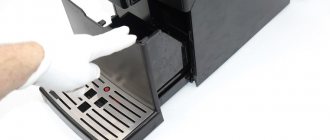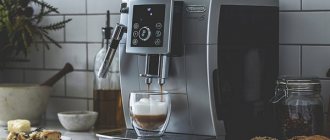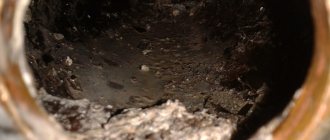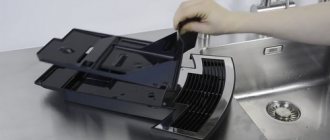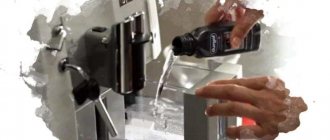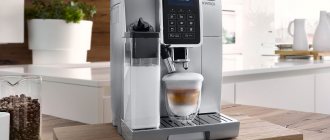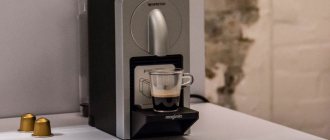Coffee machines have become firmly established in everyday life. They are used in catering, in office kitchens, at home, i.e. almost everywhere. These devices automated all stages of preparing coffee drinks, while ensuring high taste characteristics of the products. But as usual, some problems arise during their operation. One of them is the need to periodically descale the coffee machine or, to use another term, decalcify the coffee machine. This action includes washing machine parts, descaling, etc. All this will be the topic of this article.
What is decalcification of a coffee machine
Drinking water always contains a certain amount of calcium salts. There are more of them in hard water, less in soft water, but in any case they are present. During the operation of the coffee machine, these salts are gradually deposited on its various elements in contact with the aquatic environment, and over time they form plaque (scale). Because of this hardened deposit, the machine begins to work worse, and the coffee develops an off-flavor. There is only one way out of the described situation - cleaning the coffee machine from accumulated deposits, also known as decalcification.
The higher the water hardness, the more deposits will form in the coffee machine, and the more often you will have to clean it. In some cases you have to do this monthly. Therefore, it is best to use soft bottled water to make coffee; it also has a positive effect on the taste of this drink.
Can I fix the problem myself?
- The control chip of a coffee machine is a fairly delicate part, and therefore it is better to entrust its handling to a specialist;
- Diagnosing a fault often requires professional electrical equipment, which not every home has.
I will give several common and least favorite circumstances due to which equipment refuses to heat water.
Are you going to buy Red Thread from Jerusalem?
77%Yes, I'm going to23%Already bought
If a cold drink comes into the container, the source may be:
- heating element failure. It can usually burn out or break down due to the fact that its resource has expired. A break may occur in the heating element's power circuit;
- sensor failure - in this case the device cannot find the water temperature, the command to turn on the heating element is not received. Usually, the thermostat needs to be replaced;
- the vapor block is broken;
- Difficulties with the electrical control unit. In this case, the coffee machine brews cool coffee or does not heat the water at all. The reason is a breakdown of the controller - this very thing starts the operation of the heating elements and warms up the unit itself. In most cases, it is enough to replace the controller with a new one.
Difficulties with the heating block, boiler, heating element
The boiler is an essential component of any coffee machine. It is inside this iron element that the water is heated, on which the coffee is then prepared. To ensure that the taste of the drink always remains at the highest level, you need the correct coffee machine options and timely decalcification.
With such a breakdown, the drink has a very low temperature and a weaker taste. The manufacturing cycle itself takes longer than usual. The source of most problems with heating elements is scale.
Sediments are deposited on the walls in a thick layer, corroding them. The taste properties of the coffee will gradually decrease, after which a complete breakdown will occur. Another prerequisite may be that the device spends the night at low temperatures or oxidation of the contacts of the electronic circuit of the boiler.
To extend the life of the device, it is recommended to use preventive measures:
Solution: change the heating element. If you need to change the tank for heating water, it is first recommended to gain access to it; why the equipment is partially disassembled, connections are unscrewed, pipes are removed, etc. After repair, all parts are placed in place in the correct sequence. In general, it is recommended to entrust this repair to specialists.
Some coffee machines are equipped with smart boilers that can smooth out temperature, pressure, and water level with the slightest deviation from these characteristics. Repair of similar systems is carried out exclusively in service centers.
If the thermostat has failed
It makes sense to dwell on this issue in more detail. The heater thermostat automatically regulates the heating of the boiler, keeps the heating limit under control, incl. low heating Formally, we can call this thing a conditional fuse.
How scale appears
Even if you purify water with water filters, a certain amount of salts remains in it. During the process of brewing coffee, the water heats up, the salts form a solid sediment, which is deposited wherever possible. In addition to calcium salts, the oil released during the heat treatment of coffee beans contributes to the formation of various layers. It settles in the same way and thickens over time. The resulting scale is unpleasant because it negatively affects the performance of the machine, reduces its service life, and also negatively affects the taste of the coffee. To get rid of scale, specialized products are used; simply washing the coffee machine with water does not help.
Why descale
As various deposits accumulate in the components of the coffee machine, the mode of preparing the drink begins to be disrupted, in particular, the temperature of its brewing decreases. In addition, the machine begins to make noise during operation and operate intermittently. The yield of the finished drink is reduced, and its taste usually deteriorates noticeably. Comprehensive cleaning of the coffee machine, including removal of oils and descaling, brings its operating parameters back to normal, which has a positive effect on the quality of the prepared coffee. In addition, the yield of the finished drink increases, noise during operation disappears, and in general the service life of this device increases.
Keywords:
- To begin with, you should pour at least a liter of 60-degree liquid into the water bunker, adding the required amount of solution to it.
- After this, you will need to turn on the equipment and pour 2 or 3 cups of liquid with the cleaner through the hot water tap.
- Next, the hot water tap will need to be closed. Using grain or ground coffee, you should prepare several cups of the drink. It is prohibited to drink it.
- After this, you will need to turn on the automatic cleaning mode and wait for it to complete.
- After this, the machine blocks must be washed with hot water.
A capsule-type coffee machine is a device capable of preparing coffee from special hermetically sealed capsules . Each of them contains roasted ground coffee, from which the coffee maker practically itself prepares the drink intended by the manufacturer.
What products should I use to descale coffee machines?
Manufacturers of household appliances, such as DeLonghi, Dolce Gusto, Saeco, Philips and others offer their own branded products for descaling coffee machines. In principle, all these liquids and tablets can be used quite effectively to clean any model. In addition, there are similar products on sale, but not tied to any brand. Products for removing all kinds of hardened deposits can be produced in the form of washing liquids, as well as in the form of powders or tablets. In addition, you can wash the car with a self-prepared solution of citric acid.
Dolce coffee maker thick faults DIY repair
- The first thing you need to do is add water , place the coffee capsule along with the capsule receiver and lower the lever that breaks the capsule down. The horn that holds the capsule should not be there and you should directly see the needle itself for piercing the capsules.
- Then, place an empty glass and move the water supply lever to the right. First, a thin stream of water will hit, and after a few seconds steam will come out. As soon as steam comes out, return the lever to the center position.
- Actually, why all these simple manipulations... when the coffee machine runs out of water, and you do not have time to top it up, then there is air in the heating element, blocking the further continuation of the process of drawing water from the reservoir. As for the rest, the machine is practically eternal, I have already made thousands of cups at work and no problems. There is practically nothing to break there. Happy coffee drinking everyone and I hope this review was helpful to someone.
Of course, there are instructions for it, but in essence it is intuitive, all control is carried out by two buttons.
How often should you clean your coffee machine?
In principle, the frequency of cleaning this device mainly depends on the quality of the water. If hard water is used, it is recommended to clean it at least every month and a half. For soft water, this period increases to six months. You can wash the machine, focusing on external signs - an indication of the device itself or a change in the nature of its operation. This will be discussed in more detail below.
In addition to decalcification, you need to regularly clean the cappuccino machine - a device for frothing milk. It is recommended to rinse this unit with bottled water after each use, as... milk residues are a favorable environment for the proliferation of microorganisms, including pathogens. In addition, without rinsing, sediment accumulates in the cappuccino maker over time, and this unit stops frothing milk. In this case, it will have to be washed with a special washing liquid.
How to know when it's time to descale
Before you clean your coffee machine from any accumulated deposits, you need to understand whether it needs cleaning. Many models are equipped with an indication system that signals the need for a decalcification procedure. It should be understood that such systems do not determine water hardness and the amount of accumulated sediment using any sensors. They work on a very simple principle. The machine program contains the number of brewed portions of the drink (for example, 230 cups). After this limit is exhausted, the device requires decalcification, regardless of whether it is really necessary or not. In fact, the machine signals that maintenance is needed.
Some models allow the user to enter water hardness data manually. The delivery set also includes tests that allow you to determine the degree of hardness. In this case, the system gives more adequate signals about the need for decalcification.
You can also judge by eye whether your car needs to be cleaned. The following signs indicate that it is dirty and needs decalcification:
- the device is too noisy during operation, makes uncharacteristic sounds;
- the coffee stream at the exit becomes noticeably thinner than it was initially;
- ready-made coffee loses strength;
- the usual taste of the drink changes;
- the portion of the prepared drink is reduced;
- There is a noticeable sediment in the coffee cup.
All of the above clearly indicates that you cannot delay descaling the system. Otherwise, the device may fail in the near future.
Before starting the cleaning procedure, it is recommended to read the operating instructions for the coffee machine. It should describe how to carry out this procedure, and nuances specific to this particular model may be indicated.
Advantages of Nescafe Dolce Gusto capsule coffee makers
Interior design expert and fabric store manager
Nescafe Dolce Gusto coffee machines for coffee capsules are very convenient to use both at home and in the office. They do not require constant cleaning - you just need to throw away the used capsule.
Thanks to the removable capsule nest in the coffee maker, the possibility of getting burned is eliminated. The stand for cups has the same design, which at the same time acts as a container for drops.
An important advantage is the ability to independently adjust the strength of the drink. This is especially true in an office or a large family, because everyone has different tastes. Nescafe Dolce Gusto machines operate silently, they are characterized by low energy consumption and overall efficiency.
Using coffee makers you can prepare a wide range of drinks: delicate latte, aromatic cappuccino, strong espresso, as well as cocoa and tea.
All devices look stylish, modern and neat. They fit into the interior of any kitchen or office.
In addition, coffee machines are compact and save space. With them you can prepare amazingly tasty and aromatic drinks without actually taking part in this process.
While you are getting ready for work, doing household chores or solving important issues at the office, the coffee maker will make the perfect coffee based on your tastes.
What you need to clean your coffee machine
Before you descale your coffee machine, you need to decide on the cleaning method and select a substance that will remove all these fossilized deposits. This may be a branded product offered by household appliance manufacturers, or a product not associated with any brand. Branded products tend to be more expensive than others. In some cases, they are fully optimized for devices of certain brands, and manufacturers guarantee their effectiveness. The products themselves are available in a variety of forms. These can be liquids, powders or tablets. They are used according to the instructions.
Cleansing coffee oils
Coffee machine descaling products are not suitable for cleaning the kitchen unit from residual coffee oils. This requires a special cleaning agent that removes residual oils. There is no universal way to clean a coffee machine from oil residues. All stages of this process are indicated in the instructions for the unit and the cleaning product.
How to clean - products for cleaning the hydraulic system from oil residues are used as follows:
- Turn off and remove the brewing device, rinse it under a stream of water.
- Clean the dirty holes of the strainer using a regular needle or brush.
- Place the tablet in the ground coffee compartment.
- Turn on the espresso mode and place the cup.
- Drain the liquid until the reservoir is empty.
To complete the cleansing, you need to rinse the tank and after 30-40 minutes turn on the coffee making function again three times, but with regular clean water.
Cleaning the cappuccino maker
If your coffee machine has a cappuccino maker, it should also be cleaned regularly. This is done very simply. First of all, you need to remove the milk tank, rinse and fill it with filtered water.
After this, you should activate the milk supply function and run water until the tank is empty. The appearance of clear liquid indicates that the cleansing was completed correctly.
For severe contamination, the cleaning procedure is carried out using special tablets, liquids and powders.
How to descale a coffee machine: step-by-step instructions
The procedure for cleaning the coffee machine from various types of deposits on its internal parts consists of the following steps:
- First, it is recommended to clean all accessible components of the machine from coffee residues, empty the water from the water compartment, and remove waste from the tray;
- then, strictly following the instructions, you need to dissolve the cleaning agent in water, and in the specified proportion;
- the resulting solution is poured into the water compartment;
- the drink preparation mode is turned on and several portions of liquid are drained at intervals of 5-6 minutes until the water compartment is empty;
- the water tank is rinsed and filled with clean water;
- the drink preparation mode is turned on again;
- again, the water in the compartment is completely replaced and the operating mode of the machine is turned on, after which it is considered cleaned.
Models with a spray or carob type can be cleaned without adding coffee. Some models are equipped with a built-in automatic cleaning mode. In this case, removal of deposits is carried out using this mode and following the user instructions.
Semi-automatic
- Use pure or diluted vinegar as a cleaner - acetic acid helps break down the surface protective layer of parts, which accelerates the process of metal corrosion.
- Use dishwashing, glass, and plumbing detergents - these substances, even after thoroughly washing the device, can settle on the walls and get into the coffee, causing a negative effect on the human body.
- Instead of water, pass Coca-Cola or other drinks like Soda through the machine - the release of carbon dioxide can lead to breakage of small parts, which will render the entire structure unusable.
- Pour dry powders into the machine, then add water - all products are pre-dissolved in warm water, after which they are poured into a special container, from where the liquid is taken into the coffee machine.
It is recommended to thoroughly rinse all parts of the device that came into contact with the cleaner. This ensures continued safety in preparing and drinking coffee.
Table-review of purchased decalcification products
There are many products on sale that remove scale from various types of coffee machines. For ease of comparison, the characteristics of some common tools are summarized in a general table.
| Name | Type | Peculiarities | Package volume |
| Top house | Liquid or tablets | Manufactured taking into account the recommendations of manufacturers, made in Germany | 0.25 liters of liquid for two uses or 8 tablets per pack for 8 uses |
| Topper 3006 | Liquid | Manufactured taking into account the recommendations of manufacturers, made in Germany | 0.25 l for two uses |
| DeLonghi DLSC500 | Liquid | Optimized for DeLonghi equipment, but also suitable for other brands, made in Italy | 0.5 l for 4 uses |
| Philips-Saeco CA6700/00 | Liquid | It has a soft action, protects against corrosion, made in Germany | 0.25 l for one cleaning cycle |
| Melitta | Liquid or powder | Features a mild action, made in Germany | 0.25 l liquid for five cleanings or 2 sachets for two uses |
| Bosch TCZ8002 | Pills | Instant tablets, made in Germany | The package contains three tablets for three uses |
| Filtero | Pills | Instant tablets, made in Germany | Pack contains 4 tablets for four uses |
Top House
Topper 3006
DeLonghi DLSC500
Philips-Saeco CA6700/00
Melitta
Bosch TCZ8002
Filtero
Is it worth using traditional methods?
When deciding how to clean a coffee machine, you should remember the so-called traditional methods for descaling at home. In principle, you can save a little and clean your car from various salt and other deposits with such cheap and affordable products as vinegar or citric acid, since they are almost always available in the kitchen. In addition, branded liquids or tablets contain the same citric acid. But at the same time, unlike industrial products, it is easier to make a mistake in the proportions and not get the desired result, or even harm the machine. Therefore, if possible, it is better not to experiment with such products. Although it is useful to understand how to use them, so that in case of emergency (for example, if it is impossible to buy a special product), you can use them effectively without damaging the car.
Cleaning the coffee machine with folk remedies
As mentioned above, to clean a coffee machine from coffee oils and scale at home, you can use such common products as vinegar and citric acid, although in any case it is better to use specialized industrial products, which, by the way, is what repair and maintenance specialists insist on such technology. Let's look at the features of using both products.
When using filtered tap water, the intensity of the formation of various hardened deposits decreases, but does not stop. The best option is to use soft bottled water.
How to clean a coffee machine with vinegar
First you need to prepare a cleaning solution. To prepare it, you need to mix one part table vinegar (9%) and two parts water. Then proceed in the same way as when using a specialized cleaning agent. The procedure is described above. It should be said that, according to specialists in the repair of household appliances, a vinegar solution does more harm than good. It is strictly not recommended to use it regularly for cleaning.
How to clean a coffee machine with citric acid
Experts are much more favorable towards descaling a coffee machine with citric acid. The cleaning solution is prepared in a ratio of thirty grams of acid per liter of water. Further actions are the same as when using products produced at industrial enterprises. The sequence of steps is described above. According to experts, descaling a coffee machine with citric acid leads to the desired results, but such a solution is more aggressive on machine parts than specialized products. Ultimately, regular use of acid reduces the life of the machine.
What happens if the coffee machine is not cleaned?
If you do not periodically carry out comprehensive cleaning of the coffee machine, then over time it will simply fail. First, the taste of the drink will change for the worse and its output portion will decrease. Then the operation of the machine mechanism may be disrupted, and the hole through which the prepared drink enters may become completely clogged. As a result, the device becomes unusable and is not always repairable; you often have to buy a new model.
